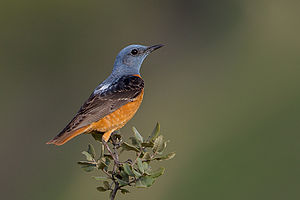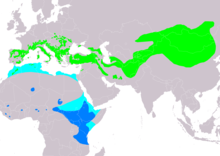Red chalk
| Red chalk | ||||||||||||
|---|---|---|---|---|---|---|---|---|---|---|---|---|

Red chalk ( Monticola saxatilis ) |
||||||||||||
| Systematics | ||||||||||||
|
||||||||||||
| Scientific name | ||||||||||||
| Monticola saxatilis | ||||||||||||
| ( Linnaeus , 1766) |
The red chalk ( Monticola saxatilis ) is a bird of the flycatcher family , which outwardly resembles a thrush . However, it has longer wings and a shorter tail and, at 19 centimeters in length, is slightly smaller than the song thrush . The tail of the females is rust-red in color. The young appear more spotted than the females. When excited, the red rubella tremble with the tail.
The downright long-distance migrant winters in the savannas of Africa south of the Sahara .
Habitat and Distribution
The species inhabits sunny slopes covered with boulders in the mountains and mountains up to an altitude of 3,000 meters. In southern Europe the stone red chalk can also be found in rocky vineyards, scree slopes and on ruins; until around 1900 there were also populations in Germany . The extinction may have been related to the then emerging trend of keeping attractive songbirds in cages. Today there are hardly any suitable biotopes in Germany because of the rationalized cultivation methods in the vineyards .
In the 20th century the red chalk was considered a breeding guest in Bavaria. In 1983 a brood was found in the Mangfall Mountains . It was not until 2000 that the species was rediscovered in the Bavarian Alps . Thereafter, in the 2010s, evidence of breeding from the Wetterstein Mountains was obtained . Since the beginning of the millennium, the red chalk has been breeding regularly in the Allgäu Alps , currently with 2 to 5 breeding pairs. The red chalk as a breeding bird is also very rare in Austria.
In Switzerland the red chalk is a regular but rare breeding bird (800 - 1200 breeding pairs), which is mainly found in the southern parts of the country.
The global distribution extends over the entire southern European region, further over Turkey and the Central Asian region to China. The species is considered not endangered worldwide.
Reproduction
In the breeding area, the male sings his powerful fluting song from a cliff, not infrequently this also happens in singing flight, to which it rises in silence and then sinks down again after an aerial caper. The nest is built in crevices, caves or wall niches. It can be up to seven meters high, but some pairs also build on the ground. The entrance of the nest, which consists of an outwardly tangled heap of stalks with a neatly incorporated nest hollow, is usually hidden by a bush. The female incubates the four to six eggs for 14 to 16 days. After about 14 days the young leave the nest and are fed for another two weeks. Afterwards they disperse to live solitary until the breeding season. In late autumn you can recognize the males by their plumage. The old males wear the brightly colored brood dress until late summer and then moult into a simple winter dress.
food
The menu includes insects , spiders and worms , even small reptiles such as lizards , but also berries and other fruits.
Danger
The species is considered to be "critically endangered" in Germany (Red List Cat. 2).
Web links
- Monticola saxatilis inthe IUCN Red List of Threatened Species 2015.4. Posted by: BirdLife International, 2012. Retrieved February 3, 2016.
- Videos, photos and sound recordings of Monticola saxatilis in the Internet Bird Collection
- Age and gender characteristics (PDF; 1.2 MB) by Javier Blasco-Zumeta and Gerd-Michael Heinze (English)
- Red chalk feathers
Individual evidence
- ↑ Thomas Rödl, Bernd-Ulrich Rudolph, Ingrid Geiersberger, Kilian Weixler, Armin Görgen: Atlas of the breeding birds in Bavaria. Distribution 2005 to 2009 . Verlag Eugen Ulmer, Stuttgart 2012, p. 202
- ↑ a b Christoph Grüneberg, Hans-Günther Bauer, Heiko Haupt, Ommo Hüppop, Torsten Ryslavy & Peter Südbeck: Red List of Germany's Breeding Birds , 5th version, November 30, 2015 . In: Reports on bird protection . tape 52 , 2015, p. 19-67 .
- ^ Red chalk. Swiss Ornithological Institute, accessed on February 14, 2016 .
- ↑ Monticola saxatilis . BirdLife International , accessed February 15, 2016 .

